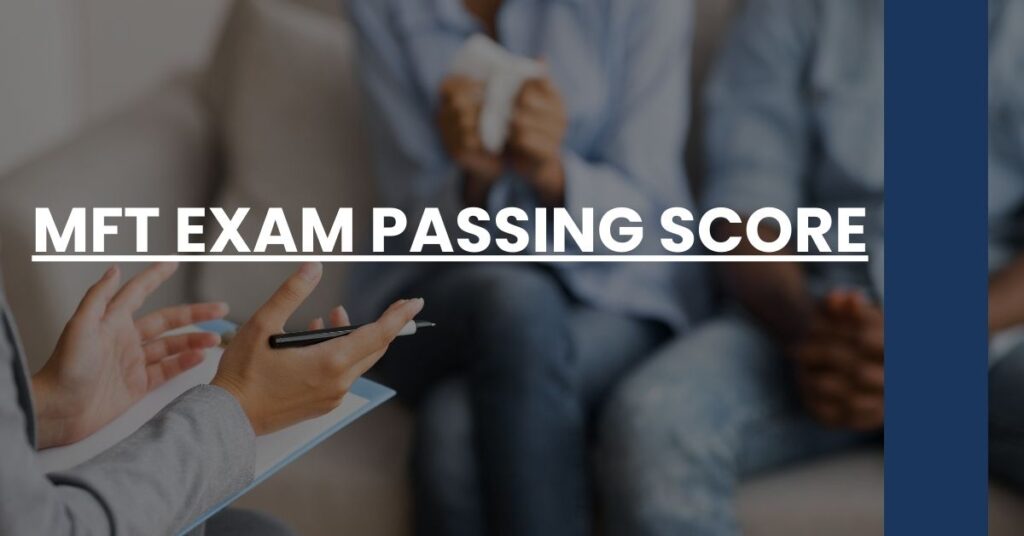The passing score for the MFT (Marriage and Family Therapy) Exam isn’t a set number—it’s determined using the modified Angoff method and varies with each exam. Achieving this score is a pivotal step in the pathway to becoming a licensed marriage and family therapist. While specifics can differ by state, preparing diligently is key to surpassing this crucial milestone.
In this article, you’ll gain insight into:
- Structure: What makes up the MFT exam.
- Scoring: How your performance translates into scores.
- Licensing: The role of your score in the bigger picture of licensure.
Ready to tackle the MFT exam? Let’s ensure your preparation aligns with the success criteria! 🎯
- Understanding the MFT Exam
- Key Components of the MFT Exam Structure
- The Passing Score: Definition and Determination
- Exam Scoring System Explained
- Minimum Score Requirements by State
- Factors Influencing the Passing Score
- How Passing Scores Are Used in Licensing
- Strategies to Achieve the Passing Score
- Recent Trends and Updates
- Frequently Asked Questions
- Conclusion
Understanding the MFT Exam
Before you embark on the journey to become a licensed marriage and family therapist (MFT), you need to understand the landmark hurdle that is the MFT Exam, officially known as the Marriage and Family Therapy National Examination. Administered by the Association of Marital & Family Therapy Regulatory Boards (AMFTRB), this exam is a standardized test that assesses your knowledge and readiness to practice therapy at a professional level.
The significance of this exam cannot be overstated. Not only does it stand between you and your license, but it’s also a marker of your competency in the field. For you to earn your credentials and begin your career aiding individuals, couples, and families, you must demonstrate that you have a strong grasp on concepts ranging from theoretical underpinnings to practical applications of therapy.
Your next step will inevitably involve an intimate dance with study materials and practice tests, but understanding the structure and details of the exam is as crucial as the studying itself. So, let’s break it down.
Key Components of the MFT Exam Structure
In preparing for the MFT Exam, it’s important for you to become acquainted with its anatomy. Knowing what to expect can dissipate some of the anxiety and allow you to tailor your study approach effectively. The exam consists of several different content areas that collectively measure your competency in the field. The areas covered may include, but are not limited to, assessing and diagnosing, designing and conducting treatment, and evaluating ongoing processes and termination of therapy.
The format is primarily multiple-choice, which may present with scenarios requiring application of knowledge rather than simple recall. Diving into example questions and practice exams may illuminate the kinds of reasoning and problem-solving skills that you will need to harness.
The richness of content and variety in question formats speak to the comprehensive nature of the MFT exam, a mirrored reflection of the nuanced field of marital and family therapy itself.
The Passing Score: Definition and Determination
As you envision conquering the MFT exam, you’re probably asking: “What is the MFT exam passing score?” Understandably, you want a number to target, a clear goal to aim for. However, the truth is a bit more complex due to the nature of the scoring system.
The passing score is not a constant; it is set for each exam administration using a method known as the modified Angoff procedure. A panel of experts reviews each item on the exam and estimates the proportion of minimally competent candidates expected to answer each question correctly. From there, these estimates are used to establish the passing standard. This process ensures the passing score is determined by the difficulty of the specific exam you take, not a pre-set number.
This means that while you might overhear specific numbers being thrown around as the “passing score,” relying on these could steer you falsely. What you should focus on is achieving a level of proficiency and understanding that would characterize a beginning level practitioner’s competency in the field of marriage and family therapy.
Exam Scoring System Explained
When you receive your exam score, you might be curious about how it was calculated. It’s important to note that the exam scores are scaled; a raw score – the number of items you answered correctly – is converted to a scaled score. This system ensures equity regardless of the variances in exam difficulties across different sittings.
To provide a little more context, imagine the MFT exam as a series of hurdles of varying heights. A scaled scoring system ensures that whether your set of hurdles was slightly higher or lower than that of another candidate, it takes the same level of effort – or competency – to clear them.
What matters most to your professional future – and what you should center your focus on – is the bridge between your current knowledge and where that score represents you need to be. Dive into the richness of the study materials at your disposal, chart your progress with practice exams, and trust in the scoring system to fairly evaluate your readiness.
Minimum Score Requirements by State
Venturing into the professional landscape, you might question how the MFT exam passing score will influence your ability to practice in different states. The answer? It varies. Each state’s regulatory board sets its own criteria for what constitutes a passing score. Essentially, while the exam is national, the benchmark for passing is localized.
This specificity means you must be vigilant in understanding the requirements of the state where you plan to practice. It is not uncommon for professionals to cross state lines throughout their careers, so an awareness of these variations can prepare you for such transitions.
For example, if you were certified in State A with a specific passing score and then moved to State B, you might be required to show you’ve met State B’s criteria. Understanding this landscape is part of ensuring your career’s portability and longevity.
Navigating these nuances might seem intimidating, but thankfully, most state boards provide clear guidelines. A proactive approach would be to research the AMFTRB site for information on state requirements. This foresight could save you from potential hiccups in your journey and keep your path to licensing smooth and unobstructed.
While this section clarifies the variability of the passing scores, you’re probably wondering how you can best prepare to meet and surpass the criteria set by any state board. Let’s now shift our focus to strategies that can bolster your chances of not just passing, but excelling at the MFT exam.
Factors Influencing the Passing Score
When it comes to the MFT exam passing score, you’re not just aiming for a static target; you’re navigating a dynamic threshold shaped by various factors. Understanding this landscape is essential, as it means you must prepare for breadth and depth in your knowledge.
Several factors contribute to the fluidity of the passing score:
- Exam Difficulty: Each exam version’s uniqueness means that the passing score takes into account the complexity of that specific set of questions.
- Psychometric Properties: Items on the test are assessed for their psychometric properties – their ability to discriminate between those who are qualified and those who are not.
- Candidate Performance: How all exam takers perform on a particular version can indirectly influence the standard-setting process.
This malleable nature is precisely why a fixation on a single number is less beneficial than striving for comprehensive mastery over the material. Your safest bet is to focus on the breadth of your knowledge and the flexibility of your problem-solving skills.
For a deeper understanding of how these elements impact your MFT exam endeavors, consider diving into the assessment of practice exams provided by the AMFTRB.
How Passing Scores Are Used in Licensing
Congratulations on reaching the coveted passing score! But what does this mean in the grand scheme of your professional journey? Your MFT exam passing score is like a golden ticket, but instead of a chocolate factory, it opens doors to state-level licensure.
Obtaining this score is just one part of a composite process. Each state’s regulatory board takes your score and, alongside other criteria such as education and supervised clinical hours, evaluates your fit for licensure. This means your impressive achievement on the MFT exam is the foundation for the competency you’ll showcase in your practice.
Remember, even if you might find yourself moving between states, the AMFTRB’s Exam Score Transfer Service facilitates the process of recognizing your score in multiple jurisdictions, further amplifying your exam success.
Strategies to Achieve the Passing Score
Now, let’s turn your attention to practical strategies to hit—and ideally exceed—the mft exam passing score:
- Comprehensive Knowledge: Ground yourself in core therapeutic models, diagnostic criteria, and ethical standards.
- Practice Tests: Regularly use practice exams to familiarize yourself with the format and to identify areas in need of improvement.
- Study Groups: Engage with peers to dissect complex concepts and foster a deeper understanding.
- Continual Learning: Attend workshops and seminars to stay updated on the latest in the field.
- Wellbeing Management: Develop a study schedule that allows for rest and personal care—mental acuity is pivotal for success.
These strategies, when executed diligently, will not only prepare you for the exam but also for a fulfilling career ahead.
Additionally, while there is no substitute for thorough preparation, you might also find value in resources such as exam preparation books and courses designed to give you an edge in your preparation efforts.
Recent Trends and Updates
The MFT exam, much like the field of therapy, is not static. It adapts and evolves to better assess the modern therapist’s qualifications. Remaining informed of these changes is non-negotiable if you’re to be adequately prepared.
Recent updates worth noting include the reduction of questions on the exam and updated methods in determining the passing score. These shifts can influence the way you approach your preparation and mindset going into the exam.
It’s advisable to consistently check the AMFTRB website or contact state boards for the most current information.
Frequently Asked Questions
Navigating through common misconceptions and questions can help slice through the clutter on your path to understanding the mft exam passing score better:
- Is there a fixed passing score? No, the passing score is established for each specific exam administration.
- What happens if I don’t pass? It’s not the end of your journey. Most therapists don’t pass on their first attempt. Assess your weaknesses, refocus your preparation, and try again with greater insight.
For more, the AMFTRB’s FAQ page can be a valuable resource when seeking clarity and additional perspectives.
Conclusion
The road to acquiring your MFT licensure is undeniably rigorous, with the MFT exam serving as one of the significant milestones. While the concept of an mft exam passing score can feel elusive, your focus should be unwavering—aim to understand, internalize, and apply the wealth of knowledge your field demands.
Equip yourself with comprehensive preparation, precise strategies, and a growth mindset that rises above mere numbers. By doing so, you not only ready yourself to surmount the MFT exam’s challenges but also to thrive in a profession dedicated to nurturing relationships and fostering resilience.
Your quest for becoming a licensed marriage and family therapist may be complex, but remember, it is a journey marked by growth, commitment, and the noble pursuit of guiding others toward wellbeing.
Achieve your MFT exam passing score with insights on success criteria, preparation tips, and understanding scoring for licensure.

